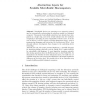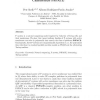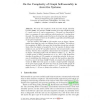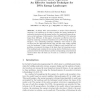DNA
2006
Springer
15 years 4 months ago
2006
Springer
DNA
2006
Springer
15 years 4 months ago
2006
Springer
P system is a natural computing model inspired by behavior of living cells and their membranes. We show that (semi-)uniform families of P systems with active membranes can solve i...
DNA
2006
Springer
15 years 4 months ago
2006
Springer
Self-repair is essential to all living systems, providing the ability to remain functional in spite of gradual damage. In the context of self-assembly of self-repairing synthetic b...
DNA
2006
Springer
15 years 4 months ago
2006
Springer
140
Voted
DNA
2006
Springer
15 years 4 months ago
2006
Springer
Minimal parallelism was recently introduced [3] as a way the rules of a P system are used: from each set of applicable rules associated to the same membrane, at least one must be a...
DNA
2006
Springer
15 years 4 months ago
2006
Springer
We examine scattered hairpins, which are structures formed when a single strand of nucleotides folds into a partially hybridized stem and a loop. To specify different classes of h...
108
click to vote
DNA
2006
Springer
15 years 4 months ago
2006
Springer
We study the times to grow structures within the tile self-assembly model proposed by Winfree, and the possible shapes that can be achieved. Our earlier work was confined to the g...
DNA
2006
Springer
15 years 4 months ago
2006
Springer
We study the complexity of the Accretive Graph Assembly Problem (AGAP). An instance of AGAP consists of an edge-weighted graph G, a seed vertex in G, and a temperature . The goal i...
98
Voted
DNA
2004
Springer
15 years 4 months ago
2004
Springer
To design DNA nano-machines or analyze DNA molecular reactions, it is important to be able to predict the energy landscape of molecular structures and the energy barrier of a trans...
124
Voted
CSB
2004
IEEE
15 years 4 months ago
2004
IEEE
RNA structures can be viewed as a kind of special strings with some characters bonded with each other. The question of aligning two RNA structures has been studied for a while, an...





